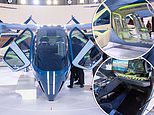
Electric vehicles are everywhere at CES 2024, but the new one on display from Hyundai-owned Supernal rises above the rest – or at least it will soon.
The S-A2 electric vertical takeoff and landing (eVTOL) is seeking approval in 2026, Neil Marshall, Supernal’s head of manufacturing strategy, told DailyMail.com.
The vehicle seats five: a pilot and four passengers. Once it enters operation, the S-A2 would move people around a city, avoiding street traffic jams.
Power comes from eight electric rotors, four in front and four in back, all battery powered. During takeoff, the front ones pivot upward while the rears face down.
Once the vehicle gets up in the air, all eight will pivot 90 degrees, with the fronts facing forward and the rears backward.
The S-A2 electric vertical takeoff and landing (eVTOL) is seeking approval in 2026
The vehicle seats five: a pilot and four passengers
At that point the vehicle stops flying like a helicopter and starts flying like a propeller plane.
It is intended to fly at speeds up to 120 miles per hour for short trips of 25 to 40 miles.
One of the main factors limiting the vehicle’s range has to do with space and weight. ‘Battery power is definitely a big problem in this industry,’ Marshall said.
Even though battery technology is advancing, it takes a ton of energy to lift a vehicle vertically and keep it in the air.
And if all that energy is coming from batteries, that could mean hundreds or thousands of pounds of batteries.
Add to that the need for extra power in case of emergencies or unexpected re-routing, and a battery-powered flying machine can only fit enough battery to go so far safely.
Currently available batteries are just barely good enough for Supernal’s purposes, said Marshall, but 10 years from now, the available batteries should be plenty sufficient, he said.
Supernal’s CES display gave some examples of trips customers might make, including from Los Angeles International Airport to Downtown Los Angeles – a little under 20 miles by roads.
In a car, depending on traffic, the trip would take anywhere from 1 to 2 hours, but Supernal estimated the SA-2 would make the trip in about 43 minutes – including a car ride to and from the ‘vertiport’ at either end.
Once it enters operation, the S-A2 would move people around a city, avoiding street traffic jams
Power comes from eight electric rotors, four in front and four in back, all battery powered
Once the vehicle gets up in the air, all eight will pivot 90 degrees, with the fronts facing forward and the rears backward
Even though the company is eager to bring the vehicle to the market, being first can have its pitfalls, Marshall said.
Part of that is production. Car makers, for instance, must make tons of cars efficiently enough to sell them at reasonably affordable prices.
If Supernal can build its eVTOLs more efficiently and cheaply, it will also be able to build more of them and run them more cheaply.
Early on, the fewer vehicles Supernal has, the more a trip will cost.
So to bring the price further away from chartering a helicopter and closer to hailing a taxi, the company will need to build more vehicles and get them into service.
Supernal wouldn’t share details on how much a trip in the S-A2 will cost.
‘Our aim is to get to that cost point whereby it’s affordable, the masses can use it,’ Marshall said. ‘This is not intended to just be aimed at high-net-worth or executive type usage.’
Supernal’s aim is to have some working models in the air in the next couple of years, with government approval beginning around 2026 and the vehicle finally being cleared for flight in 2028, Marshall said.
The company’s long-term plan is to create a network of vertiports with eVTOLs zipping in and out of them.
These vertiports will be near important destinations like airports and hospitals, the kinds of places people want to get to quickly.
Because you can’t just land an air taxi wherever you want – on the runway at the airport, or on the roof of the hospital – the vertiport network would need to be situated some distance away from these points.
And that, Marshall said, will require solutions for those first and last miles in a passenger’s eVTOL journey.
This is where parent company Hyundai would come in, with custom vehicles ferrying passengers to and from vertiports at each end of the trip, sort of like an airport shuttle.
‘At the end of the day, if people are going to pay money to pay money to take this thing, they’re paying money to save time,’ Marshall said.
Source link
CHECK OUT: Top Travel Destinations
READ MORE: Travel News



